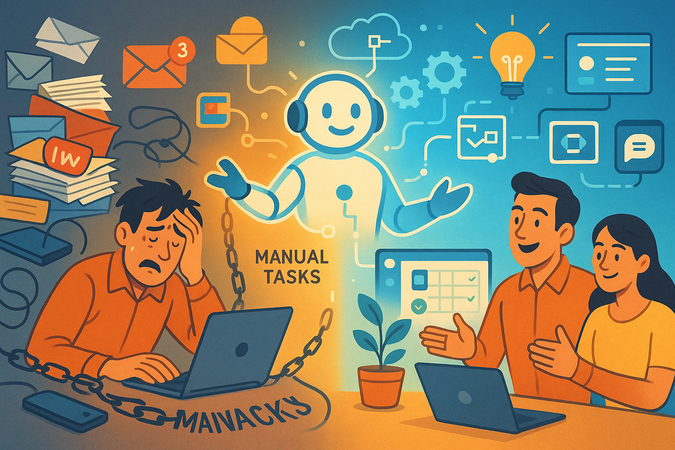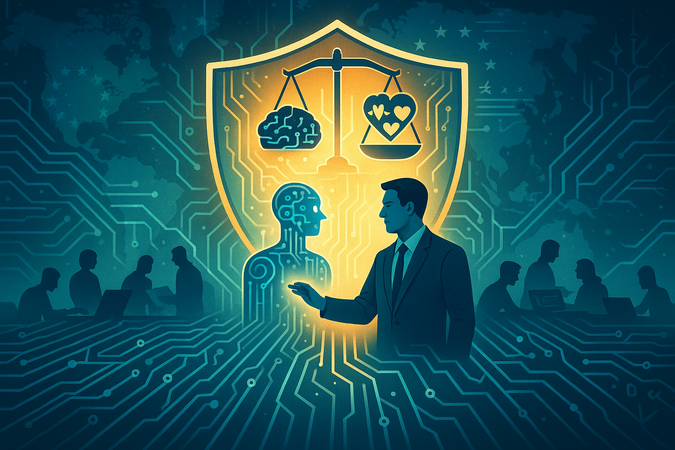Essential Skills for AI Development That Actually Matter in 2025
The generative AI market is expected to reach $1.3 trillion by 2032, up from $40 billion in 2022. This growth brings both opportunities and practical challenges for developers who need to stay relevant in an industry where technical requirements change rapidly.
Industry research indicates that employees can increase productivity by up to 38% when they effectively apply AI skills in their work. The demand for professionals with artificial intelligence expertise continues to expand across sectors as organizations integrate AI into standard operations. Nine out of ten employees want to develop their AI capabilities, understanding that these skills are already being implemented by development teams in various industries.
We are still in the early stages of how AI will reshape development practices, problem-solving approaches, and workplace methodologies. To maintain competitiveness in 2025, developers need to identify which AI tools align with their specific roles and build a combination of technical skills, analytical thinking, and ethical awareness.
What specific capabilities will separate effective AI developers from those who struggle to adapt? This article examines the essential skills that will actually matter in 2025 and provides guidance on preparing for this rapidly evolving field.
Core Technical Skills Every AI Developer Needs

Successful AI development requires mastery of specific technical competencies. While industry trends shift constantly, these foundational skills provide the stable platform needed for building effective artificial intelligence solutions.
Programming languages: Python, R, Java
Python dominates AI development environments due to its readable syntax and extensive ecosystem of specialized libraries. The language allows developers to concentrate on algorithm implementation rather than syntax complexities. Libraries like TensorFlow, PyTorch, and Scikit-learn make Python ideal for tasks spanning natural language processing to computer vision applications.
R serves data scientists who need statistical modeling and visualization capabilities. Packages such as caret, mlr3, and ggplot2 enable rapid model development with clear interpretability. Organizations typically choose R for statistical analysis and predictive analytics rather than deep learning implementations.
Java remains essential for enterprise AI systems that require robust security, scalability, and platform independence. Large organizations building AI solutions for complex IT infrastructures often select Java, supported by frameworks like Weka and Deeplearning4j.
Working with AI frameworks like TensorFlow and PyTorch
Modern AI frameworks provide the tools and abstractions necessary for building, training, and deploying artificial intelligence models. These platforms allow developers to focus on model architecture rather than low-level implementation details.
Google's TensorFlow excels in production environments with comprehensive deployment tools across multiple platforms. Its graph-based computation model optimizes CPU and GPU resource utilization. Through high-level APIs like Keras, TensorFlow provides accessibility for newcomers while offering advanced capabilities for experienced practitioners.
Meta AI's PyTorch features dynamic computation graphs (Autograd) that adapt during the learning process, providing flexibility in neural network construction. The framework's deep Python integration creates a natural development experience for developers familiar with the language.
Mathematical and Analytical Foundations
Mathematical competency separates functional AI systems from those that fail in production environments. These fundamental principles determine whether an AI model can accurately process data, learn from patterns, and make reliable predictions.
1. Statistics and probability for model evaluation
Effective AI model evaluation relies on statistical methods that quantify performance and reliability. Confidence intervals measure uncertainty in model predictions through calculations that add and subtract 1.96 × standard error of the mean (SEM). Paired-difference tests eliminate variance from question difficulty when comparing models, allowing developers to focus on actual response differences during AI evaluation. Power analysis helps researchers determine the exact number of test questions required to identify meaningful performance differences between competing models.
2. Linear algebra for neural networks
Neural networks operate through linear algebra operations at their core. Matrix storage of all network parameters enables efficient parallel processing across multiple data points. Each layer processes information through matrix multiplication, applying linear transformations to input data before activation functions introduce necessary non-linearity. Consider a two-layer neural network: input signals multiply with weight matrices to generate intermediate outputs, which activation functions then modify to produce the final results.
3. Calculus for optimization and training
Model training depends on calculus principles to achieve optimal performance. Derivatives indicate exactly how quickly loss functions change when parameters shift by infinitesimal amounts. Gradient descent algorithms use these derivative calculations to minimize loss functions through iterative parameter adjustments. Multivariate functions common in AI applications require partial derivatives and gradients to guide optimization across multiple dimensional spaces.
Applied AI Skills That Matter in 2025
Practical implementation separates theoretical knowledge from successful AI development. The skills that actually deliver value focus on hands-on capabilities that solve real business problems rather than academic concepts.
1. Machine learning and deep learning
AI professionals require proficiency across both traditional machine learning approaches and advanced deep learning architectures. Deep learning has become essential for processing unstructured data, with transformer models like GPT-4, Claude, and Gemini demonstrating sophisticated reasoning, memory, and summarization capabilities. These technologies now serve as the foundation for multimodal AI systems that can understand and generate text, images, audio, and code within a single framework.
The shift toward multimodal capabilities represents a fundamental change in how we approach AI development. Rather than building separate systems for different data types, modern AI architectures integrate multiple modalities to create more robust and versatile solutions.
2. Natural language processing (NLP)
NLP has evolved from single-purpose models to highly versatile foundation models capable of multitasking across translation, summarization, coding, and conversation without task-specific training. The global NLP market is expected to reach $156.80 billion by 2030, indicating strong enterprise adoption across industries.
Modern NLP systems support dozens of languages in real-time, expanding accessibility for global applications. This multilingual capability has become particularly valuable for organizations operating across different regions and markets.
3. Prompt engineering for generative AI
Effective prompt engineering has emerged as a critical skill for guiding AI systems to produce desired outputs through carefully constructed instructions. This technique helps AI models understand intent, follow complex instructions, and generate relevant responses. Success requires creating unambiguous prompts with sufficient context and balanced information.
Chain-of-thought prompting, which breaks complex problems into logical steps, enables developers to extract more sophisticated reasoning from AI models. This approach has proven especially effective for analytical tasks that require step-by-step problem solving.
4. Building and deploying AI models
Successful implementation depends on understanding deployment methodologies suited to specific use cases. Developers must choose between batch inference for scheduled data processing, real-time inference for immediate responses, or streaming inference for continuous data processing. Each approach involves different technical requirements and infrastructure considerations.
MLOps practices ensure models maintain accuracy and relevance in production environments. This includes monitoring model performance, managing version control, and implementing automated retraining pipelines when model drift occurs.
Soft Skills and Ethical Awareness for AI Professionals
Technical skills alone don't guarantee success in AI development. The most effective professionals combine coding expertise with strong interpersonal abilities and ethical judgment.
1. Communication with non-technical teams
Translating complex AI concepts for non-technical stakeholders represents a critical capability that many developers underestimate. Industry research indicates that up to 80% of roles require strong communication abilities. This goes beyond simply avoiding jargon—it involves using analogies, visual aids, and practical examples to make AI decisions understandable.
Effective communication builds trust among users and stakeholders because people are more likely to accept AI recommendations when they understand the reasoning behind them. For instance, explaining how a recommendation algorithm works by comparing it to how a knowledgeable salesperson makes suggestions can make the technology feel less mysterious and more trustworthy.
2. Collaboration in cross-functional teams
AI projects succeed when diverse expertise comes together effectively. The most successful implementations typically involve AI specialists, business executives, IT professionals, and domain experts working toward shared objectives. This multidisciplinary approach ensures smooth AI adoption and prevents the common problem of technically sound solutions that don't address actual business needs.
Creating environments for open communication and regular meetings supports knowledge sharing and innovative thinking. We often see projects fail not because of technical limitations, but because teams couldn't bridge the gap between AI capabilities and business requirements.
4. Problem-solving in complex AI systems
AI professionals must navigate interdisciplinary challenges that don't fit neatly into traditional technical categories. Transfer learning—applying knowledge from one problem domain to related problems—exemplifies this type of thinking. This mirrors how experienced developers build expertise: foundational skills in one area enhance learning and problem-solving in new domains.
Critical thinking becomes essential when troubleshooting issues like inaccurate predictions, data quality problems, or unexpected model behavior. The ability to systematically analyze these challenges and develop solutions often determines whether AI projects succeed or fail in production environments.
Conclusion
The field of AI development requires professionals to balance technical proficiency with interpersonal capabilities. Success depends on mastering core programming languages like Python alongside mathematical foundations in statistics, linear algebra, and calculus. Tools such as TensorFlow and PyTorch remain important, but their effectiveness relies on understanding the underlying principles that drive AI systems.
Technical skills alone are insufficient. AI professionals must communicate effectively with non-technical stakeholders and work collaboratively across disciplines. Ethical considerations, particularly bias mitigation and responsible development practices, have become as critical as coding abilities. Systems that lack transparency or perpetuate discrimination fail despite their technical sophistication.
We should focus on building balanced skill sets rather than pursuing individual trending technologies. The most valuable professionals can build sophisticated models, explain their work clearly to diverse audiences, and ensure their solutions address real-world problems responsibly.
The path to becoming a skilled AI professional requires structured learning across multiple domains. The projected growth of the generative AI market to $1.3 trillion by 2032 indicates substantial opportunities for professionals equipped with these capabilities. This field rewards continuous learning—today's advanced techniques often become tomorrow's foundational knowledge.
Organizations seeking to develop AI capabilities should invest in professionals who combine technical expertise and human-centered skills. The most successful AI implementations emerge from teams that understand both the technology and its practical applications in business contexts.
Read also: Technical documentation for IT startups
Categories
About the author
Share
Need a project estimate?
Drop us a line, and we provide you with a qualified consultation.







